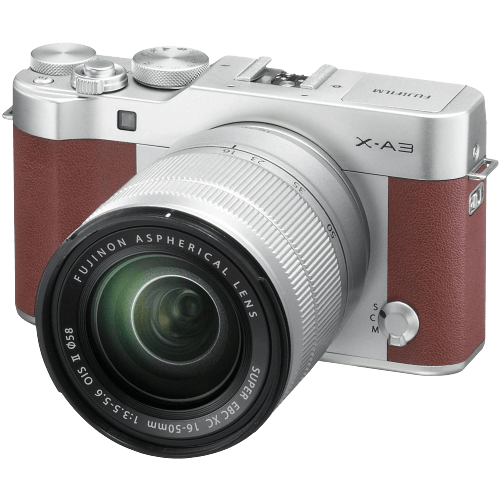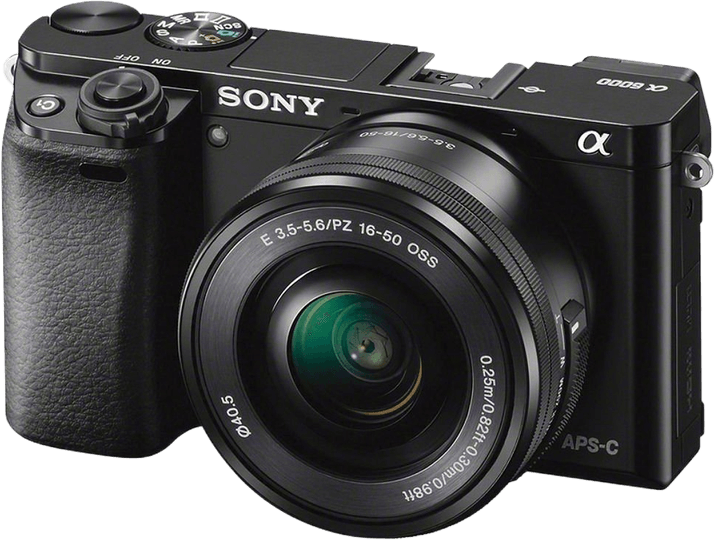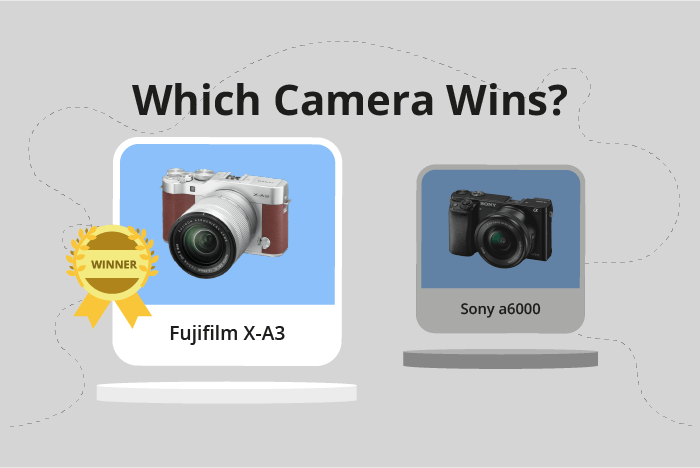Fujifilm X-A3 vs Sony a6000 Comparison
Fujifilm X-A3

Sony a6000

The Fujifilm X-A3 edges out the Sony a6000 with a score of 59/100 compared to 57/100. Both cameras are mirrorless and share similar dimensions and weight, with the X-A3 being slightly smaller and lighter. The X-A3 was released in 2016 at a lower launch price of $599, whereas the a6000 was released in 2014 at a price of $799.
The Fujifilm X-A3’s higher score reflects its better overall performance and value. Despite being newer and cheaper, it still manages to outperform the Sony a6000. On the other hand, the a6000 has a longer presence in the market, which could translate to better support and a wider range of compatible accessories.
When considering these points, the Fujifilm X-A3 offers better value for money, while the Sony a6000 may provide more options due to its longer market presence.
Fujifilm X-A3 vs Sony a6000 Overview and Optics
The Sony a6000 comes out on top in the optics comparison with a score of 67/100, while the Fujifilm X-A3 trails behind at 63/100. Both cameras share some similar specifications, such as having 24-megapixel CMOS sensors, APS-C sensor sizes, and no image stabilization. They also both use their respective company’s lens mount systems – Fujifilm X for the X-A3 and Sony E for the a6000.
The Sony a6000 pulls ahead in shooting speed, offering 11 frames per second compared to the Fujifilm X-A3’s 6 frames per second. This makes the a6000 better suited for capturing fast-moving subjects and action scenes. Additionally, the a6000 has a slightly higher megapixel count at 24.3, which can provide more detailed images. The a6000 also has a Bionz X processor and a DXOMARK sensor score of 82, which contribute to its superior image quality.
The Fujifilm X-A3, on the other hand, has an EXR Processor II, but its DXOMARK sensor score is not available since DXOMARK does not score Fujifilm cameras. This makes direct comparison difficult, but it is clear that the Sony a6000 holds an advantage in processing power and sensor quality. However, the X-A3 may still appeal to some users due to its unique Fujifilm X lens mount system, which offers a variety of high-quality lenses.
Taking these factors into consideration, the Sony a6000 stands as the better choice in terms of optics, providing faster shooting speeds, a higher megapixel count, and a more powerful processor. The Fujifilm X-A3, while not as strong in these areas, still holds value with its lens mount system and may be suitable for those with a preference for Fujifilm lenses.
Fujifilm X-A3 vs Sony a6000 Video Performance
When comparing the video capabilities of the Fujifilm X-A3 and the Sony a6000, both cameras share an equal video score of 56/100. This score reveals that the two cameras have similar video performance. Both cameras have a maximum video resolution of Full HD, with dimensions of 1920 x 1080 pixels. Additionally, they can capture video at a maximum frame rate of 60fps. Neither camera has built-in time-lapse functionality.
Despite their identical scores, the Fujifilm X-A3 has some advantages over the Sony a6000. For instance, the X-A3 features a touchscreen, which can be helpful for navigating settings and making quick adjustments while recording video. This can be particularly useful for those who prefer a more hands-on approach to their video recording experience.
On the other hand, the Sony a6000 also has its merits. It is equipped with an electronic viewfinder, which can be beneficial for framing and composing shots in bright outdoor conditions where the screen may be difficult to see. This feature is absent in the Fujifilm X-A3, making it less ideal for outdoor videography.
Taking all of these factors into account, both cameras have their individual strengths and weaknesses when it comes to video capabilities. The Fujifilm X-A3’s touchscreen may appeal to those who prioritize ease of use and quick adjustments, while the Sony a6000’s electronic viewfinder may be more suitable for those who need a more accurate view of their composition in challenging lighting conditions. Ultimately, the choice between these cameras for video recording will depend on the specific needs and preferences of the user.
Fujifilm X-A3 vs Sony a6000 Features and Benefits
The Fujifilm X-A3 emerges as the winner in terms of features, scoring 57/100, while the Sony a6000 scores 41/100. Both cameras share several specifications, including a 3-inch screen size, the absence of GPS and Bluetooth, and the presence of Wi-Fi connectivity. They both also have flip screens, making them suitable for various shooting angles and self-portraits.
The Fujifilm X-A3 outperforms the Sony a6000 in certain aspects, such as screen resolution and touchscreen functionality. The X-A3 has a screen resolution of 1,040,000 dots, providing a sharper and clearer display compared to the a6000’s 921,600 dots. Additionally, the X-A3 has a touchscreen, making it more user-friendly and convenient for adjusting settings and navigating menus, whereas the a6000 lacks this feature.
Despite the lower feature score, the Sony a6000 has its advantages. Its flip screen tilts 180 degrees, which can be useful for capturing images from various angles and positions. However, this advantage does not outweigh the benefits of the Fujifilm X-A3’s higher screen resolution and touchscreen capabilities.
Considering the differences in features and specifications, the Fujifilm X-A3 proves to be a better choice due to its higher screen resolution and touchscreen functionality. The Sony a6000 falls short in these aspects, making the X-A3 a more versatile and user-friendly option for photographers.
Fujifilm X-A3 vs Sony a6000 Storage and Battery
The Fujifilm X-A3 wins in the storage and battery comparison with a score of 24 points, while the Sony a6000 scores 21 points. Both cameras have one memory card slot and accept SD, SDHC, and SDXC cards. Neither camera offers USB charging capabilities.
The Fujifilm X-A3 outperforms the Sony a6000 in terms of battery life, providing 410 shots per charge compared to the a6000’s 360 shots. The X-A3 uses an NP-W126S battery type, which contributes to its longer battery life.
On the other hand, the Sony a6000 has a slight advantage in storage options, accepting Memory Stick Pro Duo and Pro-HG Duo cards in addition to SD, SDHC, and SDXC cards. This feature provides more flexibility in choosing memory cards for the a6000.
Taking these factors into account, the Fujifilm X-A3 offers superior battery life, making it a better choice for extended shooting sessions. However, the Sony a6000 provides more storage options, which could be beneficial for some users.
Alternatives to the Fujifilm X-A3 and Sony a6000
Are you still undecided about which camera is right for you? Have a look at these popular comparisons that feature the Fujifilm X-A3 or the Sony a6000:

